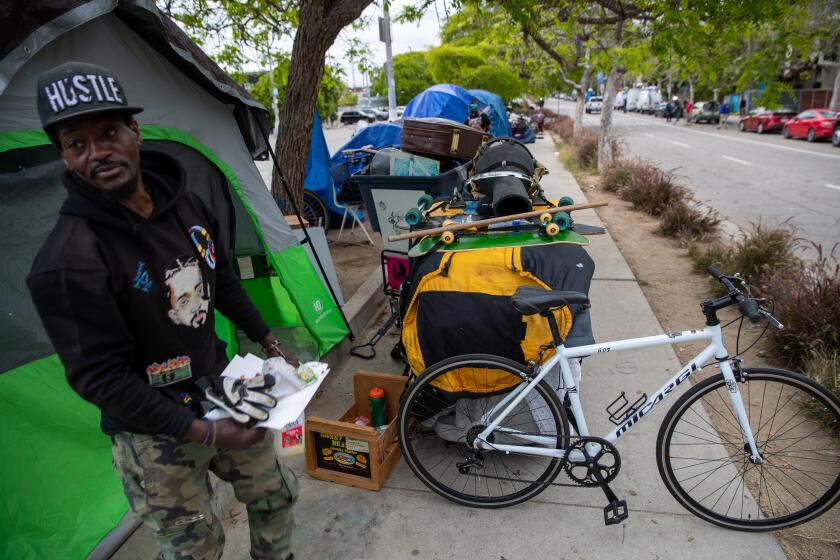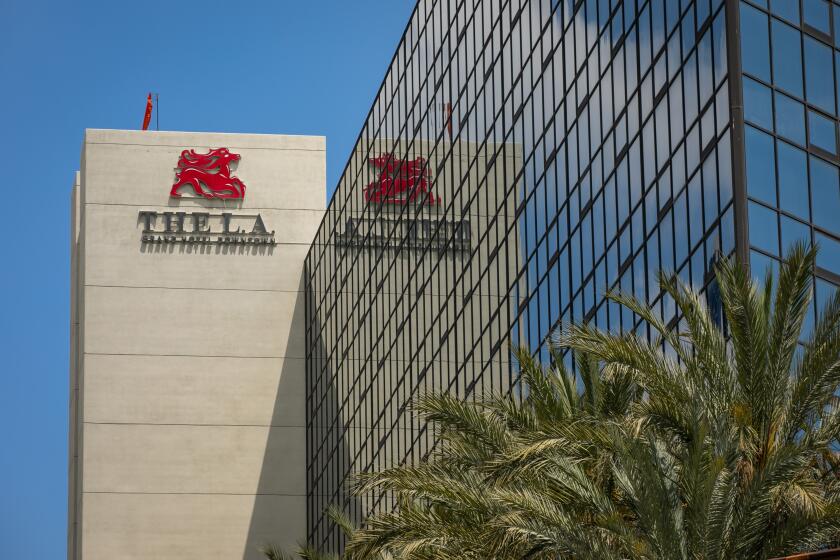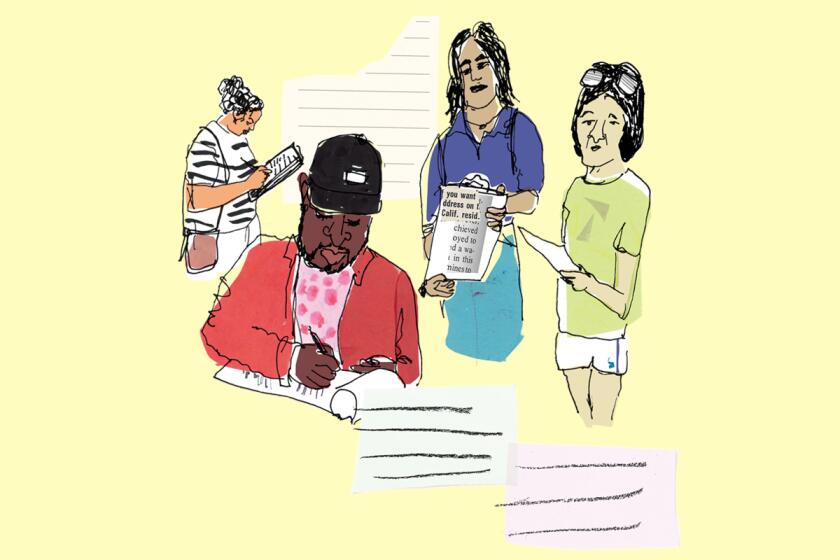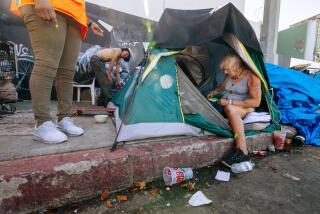Faced with another bad homelessness count, L.A. reacts with frustration

- Share via
L.A. leaders have thrown themselves into the fight against homelessness in recent years, spending an ever-growing amount of money on programs meant to pull the city’s neediest residents back from the brink.
Elected officials have celebrated the opening of new homeless shelters, cut ribbons outside nearly a dozen “tiny home” villages, and welcomed the completion of nearly 3,000 subsidized apartments — housing paid for, in part, with funds from a $1.2-billion property tax hike passed by voters.
Yet those efforts weren’t enough to alter the bleak picture laid out Thursday by officials with the Los Angeles Homeless Services Authority, which reported that, in spite of those initiatives, homelessness had gone up by 10% citywide and by 9% across Los Angeles County.
The region’s politicians, business leaders and others responded with a mix of frustration and disappointment — and even flashes of anger.
Continuing a persistent rise over the last several years, homelessness was estimated to have increased 10% in the city of Los Angeles in 2022 and 9% across the county.
Councilmember Traci Park, who represents part of the Westside, said the city has been relying on “bad policy,” devoting too few resources to the issues of substance abuse and mental health.
“It is clear to me what we have done so far has not worked,” she said. “Despite throwing billions of dollars at this problem over the last number of years, we have failed to address the growth of encampments on the streets.”
The results of the homelessness count, called “devastating” by one council member, have also become routine at this point. The city has logged an increase in seven of the last eight annual counts, even as its yearly budget for addressing the issue has exceeded $1 billion.
Mayor Karen Bass, who declared an emergency on homelessness the day she took office in December, sought to strike some optimistic themes Thursday, touting the work of her Inside Safe initiative, which has moved about 1,400 unhoused Angelenos indoors, and a newfound collaboration between the city and county officials.
Yet Bass also aired some of her own fears, saying she worries that the expiration of local eviction protections, combined with the end of various COVID-19 relief programs, will cause even more of the region’s low-income residents to wind up on the street.
“Even with all that we’re doing now, I’m worried that next year the count might be even larger,” she told reporters.
The dismal homelessness figures have put Bass, Park and other recently elected politicians at City Hall in an odd position, forcing them to answer for numbers that were collected just six weeks after they took office. The homelessness count was carried out in January, when Bass was just starting to ramp up her work in combating the crisis, taking Inside Safe to several parts of the city.
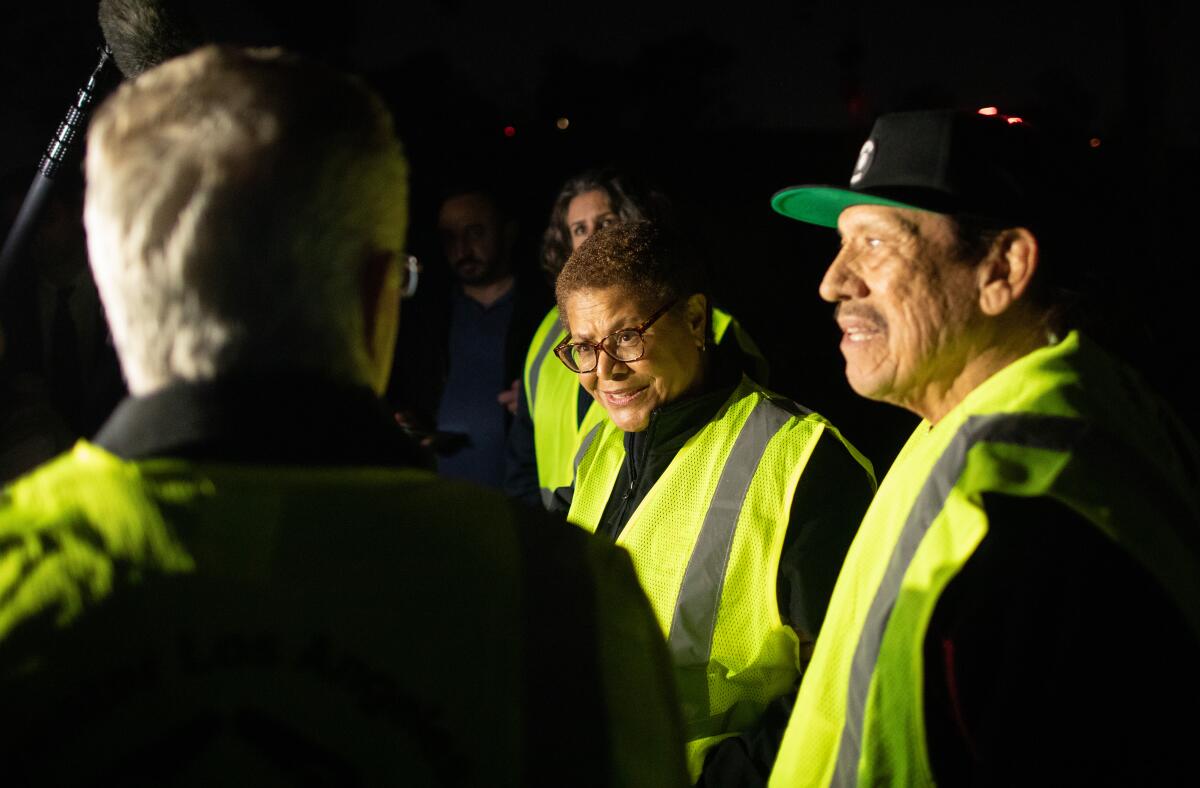
In the months since the count was conducted, Bass has secured the approval of a record $1.3 billion in spending on homelessness, as part of a city budget that goes into effect Saturday. Of that total, at least $250 million will be devoted to Inside Safe.
At the same time, the results from the latest count could provide Bass with a fresh set of arguments as she calls on other city officials to act with greater urgency, take on new government responsibilities and spend more money on the problem than ever before.
Bass recently persuaded the council to support her push to pay for treatment beds for homeless people suffering from substance use disorder — a service typically handled by county, not city, government. She has been pressing ahead with her plan to buy the Mayfair Hotel, a 15-story building she wants to use as temporary homeless housing. And she is laying the groundwork for the purchase of several smaller motels, which would also support the Inside Safe initiative.
While the mayor’s team has been working to lease and purchase hotels and motels, homeless advocates have been demanding that the city focus instead on other strategies.
Sherin Verghese, an organizer with the Koreatown-based group Ktown for All, criticized the city’s reliance on programs like Inside Safe, saying they place an excessive focus on reducing the visual impact of homelessness. Her group has been demanding additional tenant protections and the creation of new publicly owned housing.
“Every single thing that we have seen has been Band-Aid solutions,” she said.
A strike by hotel workers would disrupt operations at the L.A. Grand, which has provided rooms for homeless Angelenos since the outbreak of COVID-19.
Denise Kniter, policy manager for the Los Angeles County Business Federation, voiced confidence in Bass, saying she has taken more focused action on homelessness than her predecessors.
Still, in light of this year’s numbers, Kniter says city and county leaders should carry out a fresh assessment of their homelessness programs.
“There’s been a lot of money inserted into homelessness funding, but some of those programs are obviously more effective than others,” Kniter said.
Councilmember Nithya Raman, who heads the council’s homelessness committee, said the latest numbers are disappointing but “not totally shocking,” given what took place in the run-up to this year’s homelessness count.
Throughout much of last year, city and county leaders continued the shutdown of their Project Roomkey sites —hotels that had been converted into interim homeless housing during the pandemic, backed with federal funds. That program provided more than 4,300 rooms at its peak.
Raman succeeded in preserving one of those hotels, located in her Hollywood Hills district, as interim homeless housing. But other locations in Chinatown, MacArthur Park and elsewhere were decommissioned.
“We lost some of the shelter resources we had over the course of COVID, and in most places didn’t replace them,” Raman said.

The city could soon see a different kind of assistance from the federal government.
Last month, L.A. was one of five cities selected by the White House to participate in All Inside, a new two-year federal program targeting homelessness. That initiative, part of President Biden’s goal of reducing homelessness in the U.S. 25% by 2025, is focused in part on paring back some of the bureaucracy that prevents homeless people from getting help, according to Bass’ team.
L.A. should also experience some relief as additional projects funded by Proposition HHH, the 2016 voter-approved bond measure, continue to open up. A report issued last month by the city’s housing department said 5,700 units funded from that measure are on track to be completed over the next two years.
Voters in the city and county generally have been supportive of new efforts to address the homelessness crisis, even as the problem has grown worse.
In 2017, county voters passed Measure H, a sales tax hike to pay for apartment vouchers and social services for unhoused residents. Last fall, city voters adopted a so-called mansion tax, which could generate hundreds of millions of dollars per year but is currently the subject of a court challenge.
You can help someone get on the path to housing — and make your voice heard on issues of housing and homelessness. Learn how with Shape Your L.A.
Whether the public will continue to be generous is far from clear. Los Angeles County Supervisor Kathryn Barger, whose district stretches from Gorman on the northwest to Claremont on the east, said the newest homelessness numbers should deliver a “wake-up call.”
Barger said many cities in her district are frustrated with how the county has spent its funding from Measure H, which will expire in four years and cannot be renewed without voter approval.
“Make no mistake: If Measure H were to come before the voters tomorrow, it would fail,” she said. “Because people don’t feel like they’re seeing anything for the investment.”
Councilmember Kevin de León, whose district includes downtown, called the citywide homelessness count numbers “abysmal,” saying they underscore the need for more affordable and interim housing. De León believes those numbers will bolster his effort to bring either a tiny home village or another type of temporary homeless housing to a vacant lot across from City Hall, next to Grand Park.
“We’ve studied this to death and the answer has always been the same: more housing, urgently,” he said.
More to Read
Sign up for Essential California
The most important California stories and recommendations in your inbox every morning.
You may occasionally receive promotional content from the Los Angeles Times.
